
A roller coaster is a type of amusement ride employing a form of elevated railroad track that carries passengers on a train through tight turns, steep slopes, and other elements designed to produce a thrilling experience. Trains consist of open cars connected in a single line, and the rides are often found in theme parks around the world. Roller coasters first appeared in the 17th century, and LaMarcus Adna Thompson obtained one of the first known patents for a roller coaster design in 1885, based on the Switchback Railway which opened a year earlier at Coney Island.

Coney Island is a peninsular neighborhood and entertainment area in the southwestern section of the New York City borough of Brooklyn. The neighborhood is bounded by Brighton Beach to its east, Lower New York Bay to the south and west, and Gravesend to the north and includes the subsection of Sea Gate on its west. More broadly, the Coney Island peninsula consists of Coney Island proper, Brighton Beach, and Manhattan Beach. This was formerly the westernmost of the Outer Barrier islands on the southern shore of Long Island, but in the early 20th century it became a peninsula, connected to the rest of Long Island by land fill.
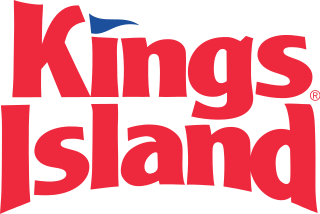
Kings Island is a 364-acre (147 ha) amusement park located 24 miles (39 km) northeast of Cincinnati in Mason, Ohio, United States. Owned and operated by Cedar Fair, the park was built by Taft Broadcasting and opened in 1972. It was part of a larger effort to move and expand Coney Island, a popular resort destination along the banks of the Ohio River that was prone to frequent flooding. After more than $300 million in capital investments over the years, the park has grown to feature over a hundred attractions including fourteen roller coasters and a 33-acre (13 ha) water park.

A roller coaster inversion is a roller coaster element in which the track turns riders upside-down and then returns them to an upright position. Early forms of inversions were circular in nature and date back to 1848 on the Centrifugal railway in Paris. These vertical loops produced massive g-force that was often dangerous to riders. As a result, the element eventually became non-existent with the last rides to feature the looping inversions being dismantled during the Great Depression. In 1975, designers from Arrow Development created the corkscrew, reviving interest in the inversion during the modern age of steel roller coasters. Elements have since evolved from simple corkscrews and vertical loops to more complex inversions such as Immelmann loops and cobra rolls. The Smiler at Alton Towers holds the world record for the number of inversions on a roller coaster with 14.

Steeplechase Park was a 15-acre (6.1 ha) amusement park in Coney Island, Brooklyn, New York City. Steeplechase Park was created by entrepreneur George C. Tilyou in 1897 and operated until 1964. It was the first of the three large amusement parks built on Coney Island, the other two being Luna Park (1903) and Dreamland (1904). Of the three, Steeplechase was the longest-lasting, running for 67 years.

The Cyclone, also called the Coney Island Cyclone, is a wooden roller coaster at Luna Park in Coney Island, Brooklyn, New York City. Designed by Vernon Keenan, it opened to the public on June 26, 1927. The roller coaster is on a plot of land at the intersection of Surf Avenue and West 10th Street. The Cyclone reaches a maximum speed of 60 miles per hour (97 km/h) and has a total track length of 2,640 feet (800 m), with a maximum height of 85 feet (26 m).

The Racer is a wooden, racing roller coaster located at Kings Island amusement park in Mason, Ohio. It was designed by John C. Allen, well-known for his contributions to roller coasters during the mid-twentieth century, and debuted at the park's grand opening in 1972. It was thrust into the national spotlight after being featured in an episode of the popular TV sitcom The Brady Bunch in 1973 and is often recognized for playing a vital role in the roller coaster renaissance of the 1970s. The Racer inspired similar designs in other roller coasters, such as Racer 75 at Kings Dominion and the now-defunct Thunder Road at Carowinds. The Racer is also one of the few original Kings Island attractions still in operation today.
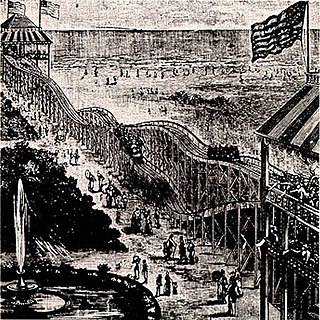
The original Switchback Railway was the first roller coaster at Coney Island in Brooklyn, New York City, and one of the earliest designed for amusement in the United States. The 1885 patent states the invention relates to the gravity double track switchback railway, which had predicated the inclined plane railway, patented in 1878 by Richard Knudsen. Coney Island's version was designed by LaMarcus Adna Thompson in 1881 and constructed in 1884. It appears Thompson based his design, at least in part, on the Mauch Chunk Switchback Railway which was a coal-mining train that had started carrying passengers as a thrill ride in 1827.

The Thunderbolt was a wooden roller coaster located at Coney Island in Brooklyn, New York. Designed by John Miller, it operated from 1925 until 1982 and remained standing until it was demolished in 2000. The demolition was controversial, as the property owner Horace Bullard was not notified, nor had any formal inspection been done on the structure.
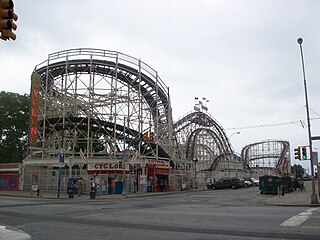
Roller coaster amusement rides have origins back to ice slides constructed in 18th-century Russia. Early technology featured sleds or wheeled carts that were sent down hills of snow reinforced by wooden supports. The technology evolved in the 19th century to feature railroad track using wheeled cars that were securely locked to the track. Newer innovations emerged in the early 20th century with side friction and underfriction technologies to allow for greater speeds and sharper turns. By the mid-to-late 20th century, these elements intensified with the introduction of steel roller coaster designs and the ability to invert riders.

Luna Park is an amusement park in Coney Island, Brooklyn, New York City. It opened on May 29, 2010, at the site of Astroland, an amusement park that had been in operation from 1962 to 2008, and Dreamland, which operated at the same site for the 2009 season. It was named after the original 1903 Luna Park which operated until 1944 on a site just north of the current park's 1000 Surf Avenue location.
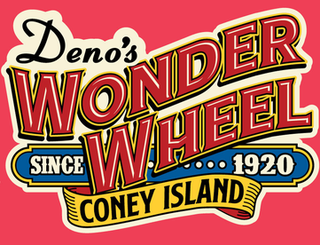
Deno's Wonder Wheel Amusement Park is a family-owned amusement park located at Coney Island, Brooklyn, New York City. It features six adult rides and 16 kiddie rides, including a dozen family rides that parents and children can ride together. The park is named for its main attraction, the Wonder Wheel, a 150-foot (46 m) eccentric wheel built in 1920.
Frederick A. Church (1878–1936) was an American engineer and early roller coaster designer. He is most famous for his "Bobs" series of roller coasters that featured severe banking, steep drops, and nonstop action.

Flip Flap Railway was the name of a looping wooden roller coaster which operated for a number of years at Paul Boyton's Sea Lion Park on Coney Island in Brooklyn, New York. The coaster, which opened in 1895, was one of the first looping roller coasters to operate in North America. It was also notable for its engineering as well as the extreme G-forces that this engineering inflicted on riders.
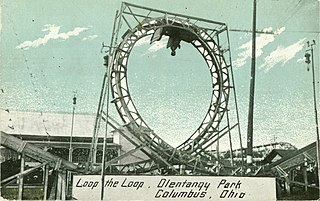
Loop the Loop was an early looping steel roller coaster which operated at Olentangy Park in Columbus, Ohio during the first decade of the 1900s. It was one of the first looping roller coasters to operate in North America, and it was designed and built by noted inventor Lina Beecher.

Loop the Loop was a dual-tracked steel roller coaster that operated on Coney Island in Brooklyn, New York, from 1901 to 1910. The coaster was one of the first looping roller coasters in North America.

Loop the Loop was a steel, dual-tracked roller coaster located in Atlantic City, New Jersey. The roller coaster opened in 1901 and operated until 1912. It was one of the earliest looping roller coasters in the United States.

Thunderbolt is a steel roller coaster at Luna Park in Coney Island, Brooklyn, New York City. It is located near Surf Avenue and West 15th Street, on the Riegelmann Boardwalk next to the B&B Carousell.

Cannon Coaster, sometimes known as Leap-the-Gap, was a wooden roller coaster which operated on Bowery Street in Coney Island, Brooklyn, New York, in the first decade of the 20th century.

Drop the Dip, later known as Trip to the Moon, was a wooden roller coaster that operated at several locations in Coney Island, Brooklyn, New York, in the early 20th century. The coaster is considered by some to have been the first truly high-speed roller coaster.






















